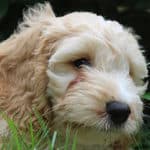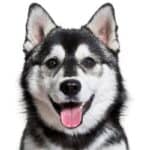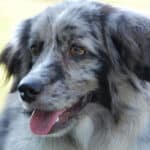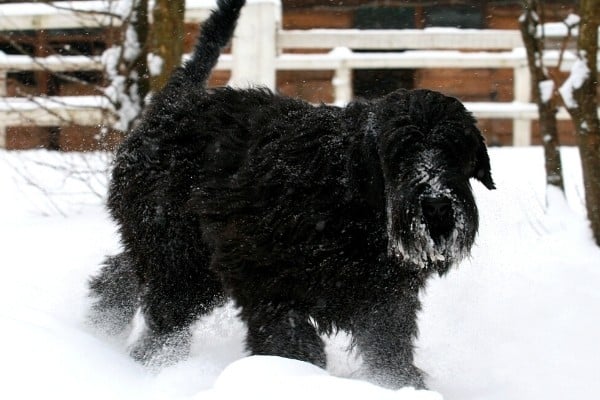
A Giant Schnoodle is one of the lesser-known Doodle dogs, but this mix is just as intriguing as the more popular Poodle crosses and has many desirable traits.
With a name like Schnoodle, you know that this dog is going to be adorable, but what else should you know about this Poodle mix?
What is a Giant Schnoodle? A Giant Schnoodle is a crossbreed resulting from the pairing of a Giant Schnauzer and a Standard Poodle. This friendly, devoted mix is prized for his nonshedding coat and intelligence, usually weighs 55 – 100 pounds, and costs between $1,000 and $2,000.
In the following, we’ll examine all aspects of the Giant Schnoodle, including appearance, temperament, training, and maintenance requirements.
Giant Schnoodle Characteristics
| Parent breeds | Giant Schnauzer and Poodle |
| Also known as | Giant Schnauzerpoo, Giant Schnauzerdoodle |
| Height | 22 – 28 inches |
| Weight | 55 – 100 pounds |
| Coat | Usually soft and wavy |
| Colors | Most common – black; many other colors possible |
| Cost | $1,000 – $2,000 |
| Temperament | Affectionate, loyal, protective, playful |
| Excessive barking? | Not likely |
| Intelligence | High |
| Trainability | High |
| Exercise needs | 45 minutes per day or more |
| Shedding | Very low |
| Hypoallergenic? | Yes |
| Grooming requirements | Low to average |
| Health | Generally healthy, but could inherit genetic conditions from untested parents |
| Life expectancy | 12 – 15 years |
What Do Giant Schnoodles Look Like?
In many ways, Giant Schnoodles look much like other Poodle crosses as they tend to have a teddy bear appearance and soft, fluffy coats.
While a Giant Schnoodle can resemble either parent breed to varying degrees, most will have a combination of traits.
For example, in many Schnoodles the dainty, chiseled features of the Poodle are blended with the blockiness of the Schnauzer, resulting in a sturdy frame and a well-muscled body.
Most Giant Schnoodles will have well-defined faces that appear alert and intelligent, thanks to the Standard Poodle but have broad, shorter muzzles, thanks to the Giant Schnauzer.
The ears almost always are folded at the base and hang down much like a Poodle’s do.
The tails are usually docked, as this is common practice with both parent breeds, though some breeders will leave the tail in its natural state upon the request of the future owner.
Giant Schnoodle Size
Most Giant Schnoodles will be under 28 inches tall (at the highest point of the shoulders) and weigh less than 100 pounds.
The best way to judge a puppy’s adult size is to look at each of the parents and inquire about the size of other dogs produced from that particular pairing.
How Big Do Giant Schnoodles Get?
As with any crossbreed, size can be a bit unpredictable and will depend heavily on the size of the parents.
Most Giant Schnoodles will stand 22 to 28 inches tall at the withers and will weigh somewhere between 55 and 100 pounds, though weights around 80 pounds are quite common.
How Long Before a Giant Schnoodle Is Full Grown?
Although growth rate can vary from dog to dog, most Giant Schnoodles will reach their full height and weight by 18 months of age.
The majority of growth, roughly 90%, will be complete by 12 months of age, and for the next six months, dogs will continue to gain muscle mass and fill out.
Giant Schnoodle Colors
Black is the most common color in Giant Schnoodles, but other colors are possible, including salt and pepper, cream, shades of brown, shades of red including apricot, silver, gray, and white.
Coats with two colors are common too. Secondary colors may appear as points of color, or they may occur in large patches, like with particolored Poodles.
Giant Schnoodle Coat
While some Giant Schnoodles may have a slightly wiry, harsh coat (like a Giant Schnauzer) and others may have a curly coat that grows quickly (like a Poodle), the majority of Giant Schnoodles will have a soft, wavy, fluffy coat of medium length, much like other Doodle varieties.
Are Schnoodles Double Coated?
While some Giant Schnoodles may inherit a double coat from their Schnauzer side, most will have a single coat like that of the Poodle.
However, the coat will be thick, plush, and dense, providing nearly as much protection against the elements as a double coat would.
Does a Giant Schnoodle’s Coat Change?
Color changes are not uncommon in Giant Schnoodles.
Some puppies may be born in a rather light shade, and as the puppy coat transitions to the adult form, the color may darken significantly, taking on a richer shade or hue.
In Giant Schnoodles who inherit the fading gene from their Poodle parent, the opposite effect may be seen with darker colors gradually fading to a lighter or “washed out” shade as the puppy matures.
Giant Schnoodle Temperament
Giant Schnoodles are typically affectionate, playful, and smart, like the Poodle, and loyal and protective, like the Giant Schnauzer.
While friendly and sociable with family and friends, he may be wary of strangers.
Usually great with children of all ages, this energetic mix will need plenty of activity to satisfy his energy levels, mental capabilities, and need to have a “job.”
Giant Schnoodle Exercise
A Giant Schnoodle is full of life and energy and will need a minimum of 45 minutes of vigorous exercise each day, though some may need one hour or more if they’re especially energetic.
A brisk walk will provide some exercise and is great for mental stimulation, but this mixed breed likely won’t be worn out with just a walk.
Free play in a fenced yard or park with plenty of room to run and chase after a ball is much better for exhausting energy levels in a dog this active.
Giant Schnoodle Puppy Care
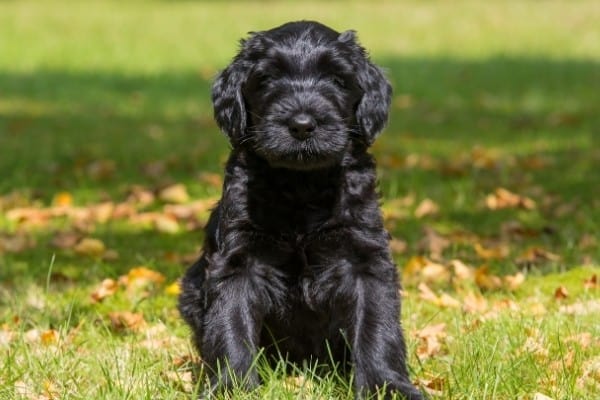
A Giant Schnoodle puppy has the same basic needs as any other breed: a healthy, nutrient-dense diet; a loving home with lots of attention and affection; near-constant supervision; and routine grooming and veterinary care.
However, as with any dog expected to be close to 100 pounds when full grown, training and socialization are crucial, and both should begin the day you bring your new Giant Schnoodle home.
Be sure to check with our Ultimate Socialization Guide and Checklist to ensure your Schnoodle will grow up to be a well-rounded, confident, trustworthy dog who will respond appropriately to a wide variety of situations.
Do Giant Schnoodles Like to Cuddle?
Cuddling is an activity that comes naturally to Giant Schnoodles.
These affectionate dogs are not clingy and “needy” like some timid breeds, but they do love their families and adore attention.
Many breeders and owners report that their Giant Schnoodle doesn’t always remember how large he is and will think nothing of climbing up on a warm lap for a snuggle and quick snooze.
Are Giant Schnoodles Good Family Pets?
A Giant Schnoodle can be a wonderful addition to a family of any size – provided that family members understand the responsibilities of dog ownership and the requirements of this mixed breed.
Giant Schnoodles are easy to train, obedient, affectionate, and good with children.
They’re energetic, alert, and naturally protective but will need proper training and socialization early in life in order to be reliable and confident.
Are Giant Schnoodles Kid Friendly?
Although the Giant Schnoodle is large, he is known for being gentle and careful with children, taking care not to accidentally knock them over during play or become too rough.
Protectiveness is an ingrained trait with this mix, so it’s not uncommon for a Giant Schnoodle to always keep a watchful eye on the youngest members of the family.
Are Schnoodles Good With Other Dogs?
While some Schnoodles may be a touch hesitant at first around new dogs, most will quickly make friends and get along well with fellow canines.
Schnoodles generally do quite well in multidog households and enjoy having another dog or two for company and backyard playtime.
Special note: If a male Giant Schnoodle strongly takes after his Schnauzer side in terms of temperament, he may not be welcoming or friendly to other male dogs encroaching on his territory.
Are Giant Schnoodles Good With Cats?
Giant Schnoodles who have been thoroughly socialized to a variety of animals, including cats, should have no trouble coexisting with family cats.
Because both parent breeds are so intelligent and eager to please their owners, even Schnoodles who are not particularly fond of cats can be trained to ignore them and leave them alone.
Can Giant Schnoodles Be Left Alone?
Like most dogs, a Giant Schnoodle can adapt to being left for short periods of time if gradually accustomed first.
However, as this is an incredibly loyal mix who forms strong attachments to his family, he’s much more content when surrounded by those he loves.
How Long Can Schnoodles Be Left Alone?
Schnoodles are not Velcro dogs, needing to be right beside you at all times, but they do center their lives around their family.
That said, most Schnoodles can adjust to being left alone for up to eight hours if you incrementally build up to that time frame over a period of weeks.
Having a friend or dog walker stop by during the day can make being left alone less stressful for your Schnoodle.
Are Schnoodles Aggressive?
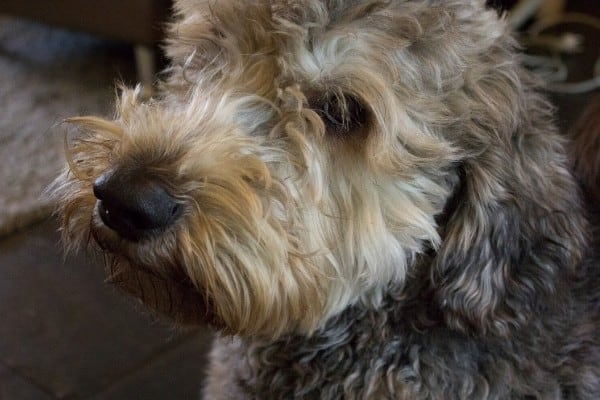
Of course any dog who hasn’t been socialized and trained properly or who has been abused in any way can be aggressive, Schnoodles, as a breed, are not prone to aggression.
While the Schnoodle may inherit territorial and/or protective behaviors from the Schnauzer parent, these traits are usually softened by the Poodle’s contribution to the mix and should never result in unprovoked aggression.
Are Giant Schnoodles Protective?
Because the Giant Schnauzer was bred to guard and protect both livestock and property, many Schnoodles will be naturally protective of their home and family without any special training.
This mix is very intuitive and will have no trouble differentiating between friend and foe.
While their sweet faces may not convey much of a threat, their size and deep bark is intimidating enough to make any intruder think twice.
Do Giant Schnoodles Bark a Lot?
Well-exercised and properly trained Giant Schnoodles should not have a problem with excessive barking.
However, any dog can become bored or frustrated when left alone for long periods or not frequently given the opportunity to exercise his body and mind.
This can result in nuisance barking, but this crossbreed is more likely to reserve his strong vocal abilities for when they are actually needed.
Can Schnoodles Swim?
Many Schnoodles love the water and enjoy swimming every chance they get.
This isn’t surprising as Poodles were originally developed to be water retrievers, a fact many people are shocked to learn.
Supervision is always important whenever your dog is around a body of water, and a bath and ear cleaning are recommended after each swim session.
Are Schnoodles Intelligent?
There’s no doubt that the Schnoodle is intelligent, able to learn, process, and retain information with little effort.
This mix is capable of quickly mastering basic obedience training and more advanced tasks as well.
In fact, some breeders are so impressed with the Giant Schnoodle’s intelligence and trainability that they’re working on developing lines specifically for service-dog roles.
In addition to being intelligent, many Schnoodles are described as being intuitive, able to assess situations quickly and “read” people with a surprising amount of accuracy.
This trait is likely a remnant of the Giant Schnauzer’s working background, where the ability to think and evaluate circumstances was a tremendous asset.
Are Giant Schnoodles Hard to Train?
With two highly intelligent, eager-to-please breeds in their lineage, it’s no wonder that Giant Schnoodles are easy to train, even for those with little experience.
Although a bit of stubbornness can’t be ruled out entirely, this crossbreed is easily motivated by food and praise, so any issues can typically be overcome quickly.
Be sure to be firm, consistent with the use of commands, practice routinely, and reward correct behavior instantly with praise and a tasty treat (these all-natural tidbits are the perfect size for training).
How Much Does a Giant Schnoodle Cost?
Giant Schnoodles typically cost between $1,000 and $2,000, though this can vary based on the breeder, parents’ pedigrees, and colors/markings of the puppies.
Here are some actual Giant Schnoodle breeders and their prices.
| Breeder | Location | Price |
| Brevard Doodles | Florida | $1,600 |
| Angela’s Schnoodles | Indiana | $2,000 – $3,500 |
| Pierce Schnoodles | North Carolina | $1,850 |
| Windy Hill Kennel | Ohio | $1,550 – $1,950 |
| Smeraglia’s Teddybear Schnoodles | Alabama | $3,495 |
| Deb’s Doodles | Montana | $2,000 |
Giant Schnoodle Grooming
About every six weeks, a Giant Schnoodle will need a full-body grooming.
A professional groomer will give the dog a bath, clean the ears, and clip the nails.
However, it’s important that owners know how to perform these routine tasks on their own and understand that regular brushing at home is important for the health of the coat and comfort of the dog.
Dental hygiene is critical for a Schnoodle’s overall health as well and should not be overlooked.
Three or four times per week, the teeth should be brushed (this complete kit comes with a dog-safe toothpaste, a toothbrush, and a finger brush), and a yearly professional cleaning is advised as well.
How Often Should You Groom a Giant Schnoodle?
The longer and more Poodle-like a Giant Schnoodle’s coat is, the more often he’ll need to be brushed.
Generally, a long or curly coat will require a thorough brushing two or three times per week while a short or wavy coat will only need brushing once per week.
A trip to the groomers every six weeks or so for a trim will keep at-home grooming to a minimum.
Best Brush for Giant Schnoodles
A slicker brush is ideal for most Giant Schnoodle coats.
Personally? I love this self-cleaning slicker brush. It’s easy on my hands and gentle on my Doodles.
A stainless steel comb is helpful for working through any tangles, and once you try a tiny bit of this detangling leave-in conditioner, you’ll never dread brushing time again.
Do Giant Schnoodles Shed?
Both Poodles and Giant Schnauzers are highly esteemed for their very low-shedding coats, and the Giant Schnoodle boasts the same bragging rights.
Giant Schnoodles do not shed much, if at all, and are considered to be an excellent choice for those with allergies.
Do Schnoodles Need Haircuts?
Most Giant Schnoodles will need a full-body trim every six weeks or so, but others may be able to go two months or more between haircuts.
In between grooming appointments, some Schnoodles will need a little touch up work done on the facial area to prevent eye irritation.
The short clip below demonstrates how easy it is to trim the entire face yourself to keep your Schnoodle comfortable.
Schnoodle Grooming Styles
Keeping the coat clipped in a short style, especially in the summer, can make life easier for you and your Schnoodle.
You really can’t go wrong with a classic puppy cut.
In this style, the coat is trimmed to a uniform length (specified by you) all over the body, except for the head area, which is usually left a little longer and rounded for a teddy bear look.
It’s a very versatile cut, and you could direct the groomer to leave the hair longer on the mustache, eyebrow, and beard area for a Schnauzer-like style or to leave the hair on top of the head long enough for a topknot if you prefer.
The choice is yours!
Best Dog Clippers for Schnoodles
Really, any clipper designed for pet grooming will get the job done, but some are definitely of higher quality than others.
You could pay hundreds and then still need to purchase guards, extra blades, and scissors.
Or you could be smart and get an affordable, complete kit that has everything you need.
This clipper set is perfect and very reasonably priced.
It comes with six guards, runs quietly, includes blunt-end scissors and a comb, and can be used with or without the cord.
Regardless of whether your Schnoodle’s hair is similar to a Schnauzer’s or a Poodle’s, this clipper will go through it like a hot knife through butter.
How Often Can I Give My Schnoodle a Bath?
A bath once every four to six weeks is usually sufficient for a Giant Schnoodle, unless of course he gets into something he shouldn’t, in which case an extra bath is fine.
Avoid bathing too frequently as this could strip the skin of oils, leaving it dry, scaly, and itchy.
Always use products formulated for dogs (this brand is gentle and hypoallergenic – I use it on my own Doodles).
If you choose to use a hair dryer afterward, use only the lowest heat setting, and hold it several inches away from the dog’s skin.
What Health Problems Do Giant Schnoodles Have?
Although Giant Schnoodles are considered to be generally healthy, it’s possible that they could suffer from conditions known to occur in either parent breed, especially if the condition is common to both Giant Schnauzers and Standard Poodles.
Breeders should have each breeding dog tested for hip, eye, and thyroid conditions prior to breeding.
Possible conditions include:
- Eye disorders, such as progressive retinal atrophy and cataracts.
- Hypothyroidism.
- Von Willebrand’s disease.
- Hip or elbow dysplasia.
- Heart disease and defects.
- Autoimmune disorders, such as autoimmune thyroiditis.
- Cancer.
- Patellar luxation.
Giant Schnoodle Life Expectancy
Many Giant Schnoodles will live into their early to mid teens, though life expectancy is merely a reasonable estimate – not a guarantee.
A dog’s life expectancy can be shortened by many factors, including subpar or complete lack of veterinary care; genetics; diet; environmental factors, such as second-hand smoke, pollutants, and toxins; and lack of physical activity.
How Long Do Giant Schnoodles Live?
A well-cared-for Giant Schnoodle typically has a lifespan between 12 and 15 years.
The Standard Poodle’s life expectancy is 10 – 18 years, and Giant Schnauzers average 12 – 15 years, so anywhere within these ranges is to be expected for their offspring.
Related Question:
What is a Teddy Bear Schnoodle?
“Teddy Bear” is often tacked on to the Schnoodle name as a selling tactic.
Teddy Bear Schnoodles are Schnoodles in every way; the term teddy bear simply serves to describe the boxy heads and soft, lush coat found on many Doodle dogs.
Smeraglia’s Teddybear Schnoodles claims to be the first breeder to use this descriptive wording for Doodles when she first bred English Goldendoodles.
Last update on 2024-04-25 at 00:59 / Affiliate links / Images from Amazon Product Advertising API








